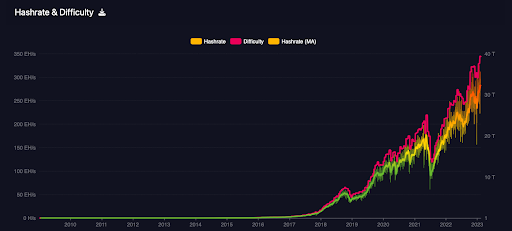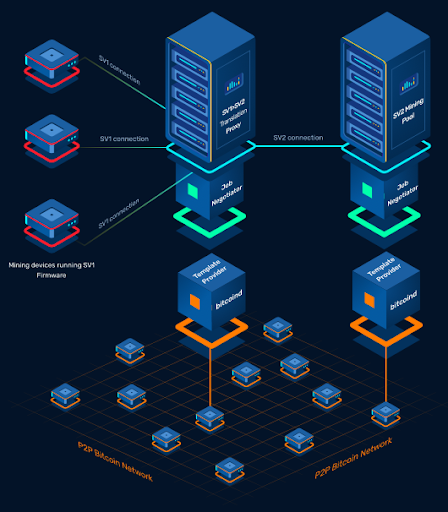The Bullish Case for Stratum v2
Stratum v2 is the missing piece of the decentralization puzzle for Bitcoin.

Every ten minutes or so the Bitcoin network creates a new block of transactions.
Who decides which transactions go into those Bitcoin blocks?
If your answer is miners, you’re wrong.
This article will bring a few more surprising facts that will help you understand the current status of Stratum v1, the industry-adopted mining protocol, and why a change in the bitcoin mining protocol is much needed. We will build a bullish case for Stratum v2 — a protocol upgrade that helps address all the concerns we’ll bring up.
Today, Bitcoin is mainly controlled by a handful of centralized mining pools that decide which transactions are constructed in a block. This isn’t good for the decentralization of the world’s next reserve currency. When we consider recent events on other networks, having centralized decision-makers in a decentralized system is an attack vector that will eventually be exploited.
Here’s another surprising fact. The last time we had a change in the Bitcoin mining protocol was in 2012. Hashrate, a measurement of the computational power miners, mining pools, and proxies contribute to the network, has snowballed since then, and Bitcoin mining has become a serious industrial undertaking.
While the hashrate growth as a sole metric may not mean much, it raises eyebrows. In a rapidly growing industry where things change daily, the last time we had a mining protocol change was over a decade ago!

Are you ready for another one? Did you know that communication between mining devices, pools, and proxies that aggregate connections is unencrypted?
It’s 2023, and the entire mining industry isn’t even using basic encryption as a security mechanism. That means they’re vulnerable to a basic man-in-the-middle attack. Anyone able to intercept the connection could easily steal hashrate and point it to their farm. This attack has been proven, and it’s happening. However, mining pools don’t disclose it publicly because it’s a bad look for their business.
The current protocol everyone uses, Stratum v1, isn’t standardized. For example, it doesn’t include a proxy in the specs, so mining farms are left to improvise on implementing this important infrastructural component.
Stratum v2 is a next-generation protocol for pooled bitcoin mining. It defines how miners, proxies, and pools communicate to contribute hashrate to the Bitcoin network. Compared to its predecessor, Stratum v2 adds layers of improvements, such as enhanced security, standardization, flexibility, efficiency, and, most importantly, censorship resistance for the entire network.
Stratum v2 is the missing piece of the decentralization puzzle for Bitcoin. Currently, when a miner participates in pooled mining, the pool itself has the only say on which transactions go into blocks. This is a massive censorship problem. For Bitcoin to be fully decentralized, we must get rid of the centralization of power in a handful of mining pools.
Stratum v2 does this by implementing what is called the Job Negotiator sub-protocol, which provides a block template that allows individual miners to run a full node and construct their own blocks. The mining pool must accept whatever miners propose. If they decline, miners will fall back to a different pool or mine on their own. The Job Negotiator can be run by a miner or an independent third party, allowing greater flexibility and outsourcing responsibility from a centralized mining pool to anyone wanting to run it.
Stratum v2 uses NOISE encryption and authentication. Communication between the participants is no longer susceptible to a man-in-the-middle attack or hashrate hijacking. The protocol is binary, which improves efficiency. For example, the binary protocol allows less bandwidth usage, meaning miners in remote areas could benefit from upgrading to Stratum v2. The protocol is clearly defined and standardized, so there’s no room for ambiguity.
Stratum v2 is flexible. Multiple sub-protocol and configurations can satisfy any need and allow greater modularity to the setups. For example, we’ve implemented a Translation proxy that will enable miners running Stratum v1 firmware to connect to the Stratum v2 pool, so a sensitive thing such as a firmware upgrade isn’t needed to use Stratum v2. However, manufacturers could undoubtedly benefit from shipping their devices with Stratum v2 firmware, one such example is Braiins OS.

The Stratum Reference Implementation puts interoperability as its highest priority. That’s why we’ve developed Message Generator — a tool that allows different implementations of the Stratum v2 protocol to test against each other and the reference implementation to ensure interoperability.
Currently, there are two implementations of the Stratum v2 protocol:
Braiins implementation
SRI (Stratum Reference implementation)
Braiins understands the importance of having an independent, community-run, and completely open-source implementation.
If you’d like to donate to Stratum V2, please visit the OpenSats page here.
Sign up to start saving Bitcoin
Buy automatically every day, week, or month, starting with as little as $10.
More from Swan Signal Blog
Thoughts on Bitcoin from the Swan team and friends.


MSTR vs. GBTC Compared: Which is Best in 2024?

By Drew
This article compares MSTR and GBTC, offering insights for investors by examining their features, benefits, performance, fees, and drawbacks, focusing on their role in Bitcoin investment strategies.


Changing Bitcoin: The Past, The Present, and The Future (Part One)

By Tomer Strolight
For Bitcoin to achieve the lofty goals many have for it, its rules will need to change. This three-part series of articles will tackle what it takes to change Bitcoin.


4 Reasons to Avoid Coinbase In 2024?

By Matt Ruby
The crypto platform is facing all kinds of problems. Is it time for customers to seek out an alternative?